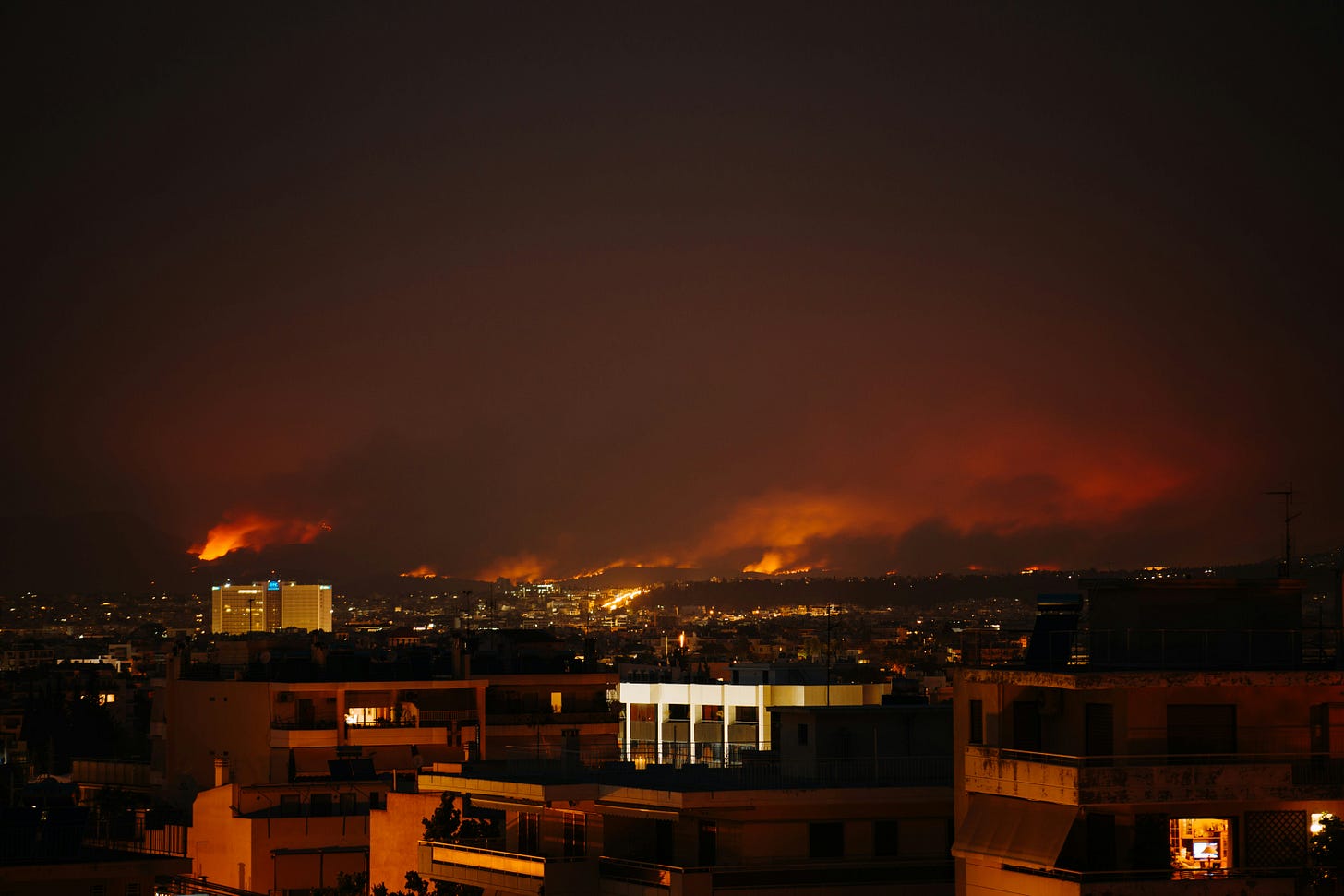Athens is raging with wildfires, yet the city needs to plant more trees
The suburbs of Athens are raging. Wildfires have plagued the North of the city over the past weeks, shutting down the neighbourhoods of Nea Penteli and the town of Varnavas. They follow in the wake of temperatures that have again hit new highs: July in Greece was the hottest on record yet again, after setting a similar milestone for June. Wildfires have scorched a dark edge on the laid-back summer season for years and in some ways are part of the cultural landscape in Greece and across the wider Mediterranean. But their increased severity and encroachment on the Greek capital, one of the densest cities in Europe, is alarming.
Photo by Anasmeister, Unsplash
Athens has a population density of about 17,000 people per square kilometre — that’s about double the density of LA. The capital's suburbs boomed since the 50’s, building into the hills and the forests of Attica. Fires have often been blamed on arsonists wanting to clear areas of forest to use land for commercial purposes.
Yet in urban planning terms, density is normally considered positive. Dense cities are usually more sustainable, with people owning smaller homes therefore consuming less energy. A less sprawling city makes it easier to get around by public transport. And on the social side, communities tend to be tighter knit, with livelier street-life. It’s not uncommon in Athens for generations of the same family to live in the same building, or at the very least close by in the neighbourhood.
In terms of wildfires, there’s a different story. Researchers at the University of University of Wollongong, Australia have studied the correlation between wildfires and density in Sydney concluding that ‘urbanisation is a double-edged sword because it both increases the likelihood of ignition but also protects areas from fire spread.’
Photo by Anasmeister, Unsplash
And here lies the dilemma — in a city that is heating dramatically, one of the most effective ways of cooling would be to plant trees. As one of Europe’s densest cities, it offers only 0.96 square metres of green space per resident, falling well short of the World Health Organisation’s (WHO) recommendation of nine square metres per capita. Athens boasts a big city vibe of concrete and asphalt, with just a little respite in its southern neighbourhoods which border the Aegean Sea. According to the WHO the heat Island effect exhibits up to 10°C difference between the centre of the city and its suburbs — and it’s only getting worse. The City of Athens is the hottest mainland European Capital, exacerbated by traffic and air pollution.
According to a 2019 report by Eleni Myrivili, Senior Advisor for Heat Resilience for the City of Athens and Global Chief Heat Officer UN-Habitat the concretization of the city increased from 17% in 1945 to 68% in 2000. “There is hardly any countryside left around Athens, the suburbs are nibbling away and destroying everything. Economic interests are taking priority over the need for green space,” says Greek Urban planner Aris Kalandides.
Yet, in the long-term this remains a false economy. In Central Athens, heat-related output losses from labour productivity are projected to more than double from almost USD 100 million in a typical year today to USD 230 million (EUR 213.7 million) in 2050 as temperatures soar. In 2019, Myrvili reported that there was a lack of prioritisation of climate risks among government, with weather issues are at the top of the agenda (economic, social, waste management, etc) and climate resilience not guiding decision making or budgeting. 5 years later it's impossible to ignore.
So — trees to the rescue. Athens' mayor, former energy professor Haris Doukas, has planned to plant 25,000 trees over the next five years to try to cool the Greek capital. The idea is to create "cool routes" of shade connecting Athens' streets, scant parks and urban hills, as has been seen successfully in cities like Medellin, Colombia.
In an interview with The Guardian earlier this year, he raised the stakes — “It's not a matter of lifestyle, or improving the quality of life; it's about survival when 23% of the green lung around Athens has in recent years been destroyed by fires. It's vital we have more trees, more air-conditioned community centres and more water stations on our streets and squares.”
The question is ‘what type of trees?’ Mediterranean pines are native, quick growing and naturally reseeding — but they act like fire bombs when they catch alight. One of the issues in the latest fires has been the pine cones, which explode and carry fire further. Eucalyptus is great in dry conditions, but burns easily because it contains a lot of oil, and its leaves and bark are also very flammable. The evergreen Holm oak, is very well adapted to withstand fires with a humid understory that prevents fire spread, but will be harder to grow in drier conditions. Mediterranean Cypress is the big survivor, with a unique protective structure. A study found that incredibly 98% or more of Mediterranean cypress trees were still standing, tall, and green after a fire.
Photo by Filippos Sdralias, Unsplash
In a myth-busting report ‘Fire and forest fires in the mediterranean; a relationship story between forests and society’ by The Forest Sciences Centre of Catalonia, researchers cite one the major reasons for the mega-fires that are spreading across the region is ironically rewilding of forests in unplanned ways as traditional practices of forest grazing have been lost, creating plenty of undergrowth that is literally rocket fuel for the fire. Metaphorical as it might seem, they point out that ‘the extension and severity of Mediterranean forest fires are a reflection and a consequence of the present-day relationship that, as a society, we have with forests.’
When daily life becomes detached from the natural world, our direct interactions with nature decrease, and nature slowly fades into the background. Historically, Athenians returned to villages and family farms in the countryside on weekends and for holidays, but as the Greek diaspora grew abroad prolonged by the 2008 economic crisis, fewer contemporary Athenians have had access to a rural ancestral home, displacing the traditional cultural relationship with the landscape.
New large-scale emergent landscape projects are setting out to reverse that. The Stavros Niarchos Foundation’s Park in the district of Kallithea is to date the largest public Mediterranean garden in the world. Ellinkinon’s future park development in the south east of the city will be larger than the entire state of Monaco. But their importance lies beyond scale and numbers. The designers of Ellinikon Park, the landscape architects Sasaki, describe how ‘a foundational goal for the park is to engage Athenian society in a 21st century landscape’ creating a place that ‘reinstates a relationship with nature and demonstrates Greece’s commitment to climate positive design.’ No easy task in a gas-guzzling, air-conditioned city like Athens. But when citizens feel first-hand the traumatic impacts of this fast heating world, that’s a huge tipping point in behaviour change. To survive on the front-line of the climate crisis, Athens may have no alternative.







